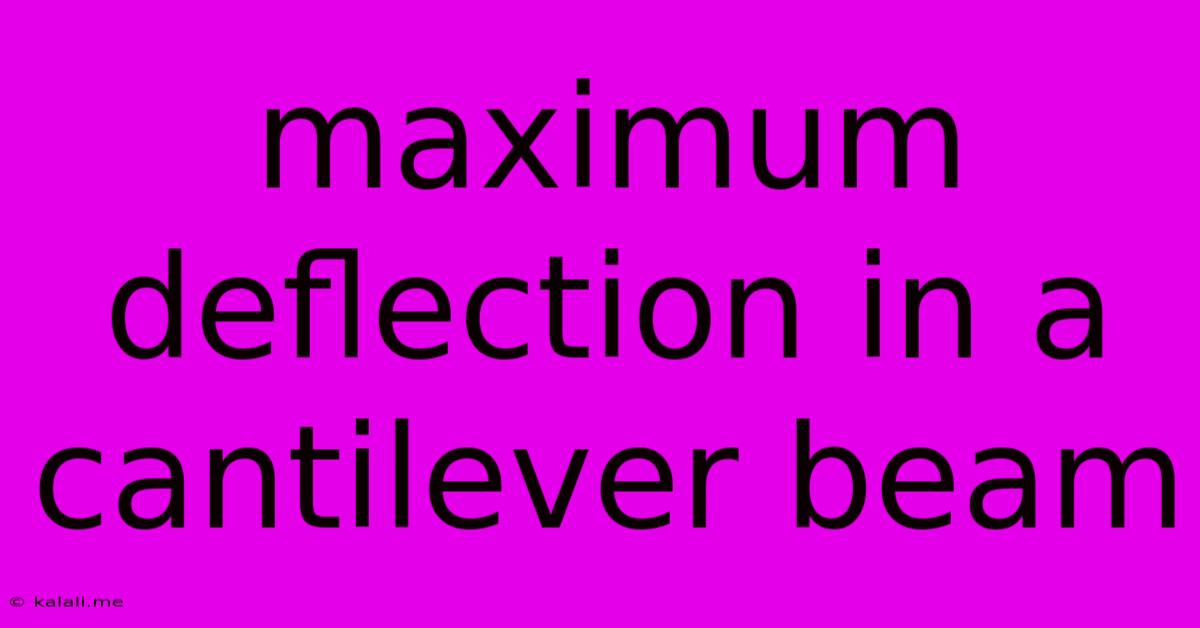Maximum Deflection In A Cantilever Beam
Kalali
Jun 16, 2025 · 3 min read

Table of Contents
Maximum Deflection in a Cantilever Beam: A Comprehensive Guide
Meta Description: Understanding maximum deflection in cantilever beams is crucial for structural engineers. This guide explores calculation methods, influencing factors, and the importance of deflection limits for ensuring structural integrity. Learn how to determine maximum deflection and avoid potential structural failures.
Cantilever beams, beams fixed at one end and free at the other, are commonly used in various engineering applications. Understanding the maximum deflection of these beams is paramount to ensure structural integrity and prevent failure. This article provides a comprehensive guide to calculating maximum deflection, considering various loading conditions and influencing factors.
What is Maximum Deflection?
Maximum deflection refers to the largest vertical displacement a cantilever beam experiences under a given load. This displacement occurs at the free end of the beam, furthest from the fixed support. Excessive deflection can lead to structural instability, fatigue, and ultimately, failure. Therefore, accurately calculating and managing maximum deflection is a critical aspect of structural design.
Factors Affecting Maximum Deflection
Several factors influence the maximum deflection of a cantilever beam:
-
Material Properties: The Young's modulus (E) and the moment of inertia (I) of the beam's cross-sectional area significantly impact its stiffness and, consequently, its deflection. A higher Young's modulus indicates a stiffer material, resulting in less deflection. Similarly, a larger moment of inertia (related to the beam's shape and size) leads to increased stiffness and reduced deflection.
-
Beam Length (L): The longer the cantilever beam, the greater the deflection under the same load. Deflection is directly proportional to the cube of the length (L³).
-
Applied Load (P): The magnitude of the applied load directly affects the deflection. A larger load results in greater deflection. The type of load (point load, uniformly distributed load, etc.) also influences the calculation method.
-
Beam Geometry: The cross-sectional shape of the beam affects its moment of inertia and thus its stiffness. Beams with larger cross-sectional areas generally exhibit less deflection.
Calculating Maximum Deflection
The calculation of maximum deflection depends on the type of load applied to the cantilever beam. Here are some common scenarios:
1. Point Load at the Free End:
For a cantilever beam with a point load (P) at the free end, the maximum deflection (δ<sub>max</sub>) is given by:
δ<sub>max</sub> = (PL³) / (3EI)
2. Uniformly Distributed Load (UDL):
For a cantilever beam with a uniformly distributed load (w) along its length, the maximum deflection is:
δ<sub>max</sub> = (wL⁴) / (8EI)
3. Other Load Cases:
More complex loading scenarios may require more intricate calculations, often involving integration techniques and superposition principles. Engineering handbooks and software packages can assist in these calculations.
Importance of Deflection Limits
Building codes and design standards specify allowable deflection limits for cantilever beams. These limits ensure the beam's serviceability and prevent excessive deformation that could compromise structural integrity, affect functionality, or cause damage to non-structural elements. Exceeding these limits can lead to:
- Cracking: In brittle materials, excessive stress caused by deflection can result in cracking.
- Fatigue Failure: Repeated deflection can lead to fatigue failure over time.
- Aesthetic Issues: Excessive deflection can negatively affect the appearance and functionality of the structure.
Conclusion
Accurate determination of maximum deflection in cantilever beams is crucial for structural design. Understanding the influencing factors and applying the appropriate calculation methods are essential for ensuring structural safety and serviceability. Adhering to allowable deflection limits specified in design codes and standards is vital for preventing structural failures and maintaining the integrity of the structure. Remember to consult engineering handbooks or software for complex load scenarios and ensure compliance with relevant building codes.
Latest Posts
Latest Posts
-
Select The Term With The Correct Spelling
Jun 16, 2025
-
If Qt Is Perpendicular To Pr
Jun 16, 2025
-
History Multiple Choice Questions And Answers Pdf
Jun 16, 2025
-
American University Of Paris Acceptance Rate For International Students
Jun 16, 2025
-
Which Of The Following Statements Is True Of Lake Victoria
Jun 16, 2025
Related Post
Thank you for visiting our website which covers about Maximum Deflection In A Cantilever Beam . We hope the information provided has been useful to you. Feel free to contact us if you have any questions or need further assistance. See you next time and don't miss to bookmark.